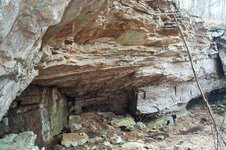Mad Martigan
Greenie
Howdy guys I've been digging for Indian artifacts for a few years now off and on and Id like to start by saying that the cliffs I dig are on property that is gonna be destroyed by surface mining...so I'm actually saving the artifacts rather than destroying them. I do have many questions that im hoping someone on here can answer.
1) In some cliffs I have found arrowheads on the surface but when i dig down i barely find any flint and no points as of yet, why?
2) How do you know when your deep enough? I have found arrowheads and when i keep on digging down I find charcoal, does the charcoal infer that im still not deep enough?
3) Ive heard that the black and sometimes orange color on the tops of Indian shelters is from years of smoke is this true?
4) Are paleo points usually gonna be where other indian relics are just deeper?
5) How does indian material like charcoal,flint celts settle over time I mean is the heavier stuff gonna be deeper or what?
6) Where did Indians like to bury their dead in the mountains? Ive heard they did it on ridge lines facing the east is this true?
7) How can you spot an indian grave in a hill region like south eastern Ky, where do you look?
8) Finally and this is the most perplexing issue for me, how do I spot an indian camp that wasnt under a cliff? I have no idea how to even start to look for that?
Thanks hope to get some good answers, Adam
1) In some cliffs I have found arrowheads on the surface but when i dig down i barely find any flint and no points as of yet, why?
2) How do you know when your deep enough? I have found arrowheads and when i keep on digging down I find charcoal, does the charcoal infer that im still not deep enough?
3) Ive heard that the black and sometimes orange color on the tops of Indian shelters is from years of smoke is this true?
4) Are paleo points usually gonna be where other indian relics are just deeper?
5) How does indian material like charcoal,flint celts settle over time I mean is the heavier stuff gonna be deeper or what?
6) Where did Indians like to bury their dead in the mountains? Ive heard they did it on ridge lines facing the east is this true?
7) How can you spot an indian grave in a hill region like south eastern Ky, where do you look?
8) Finally and this is the most perplexing issue for me, how do I spot an indian camp that wasnt under a cliff? I have no idea how to even start to look for that?
Thanks hope to get some good answers, Adam
Amazon Forum Fav 👍
Upvote
0






